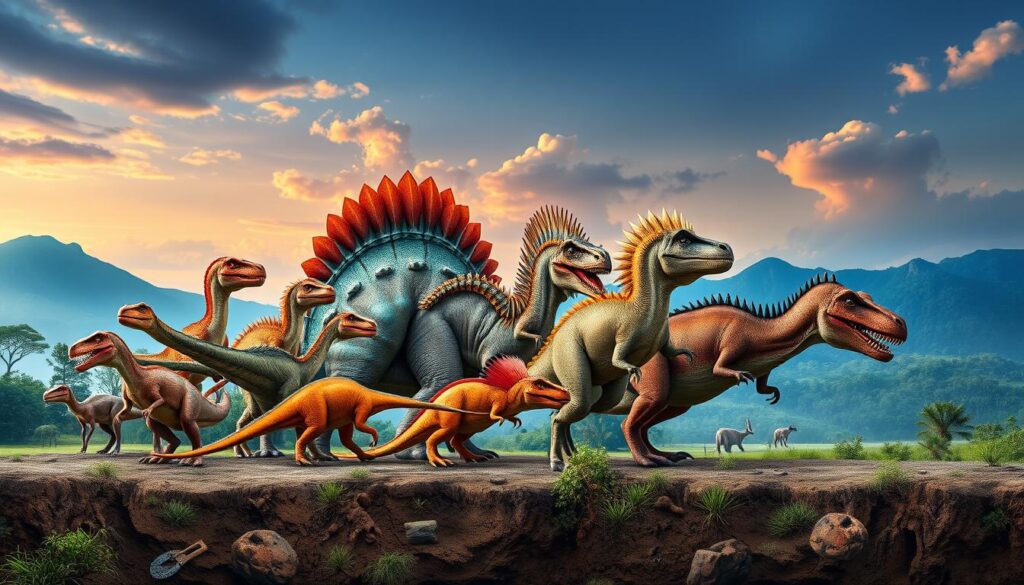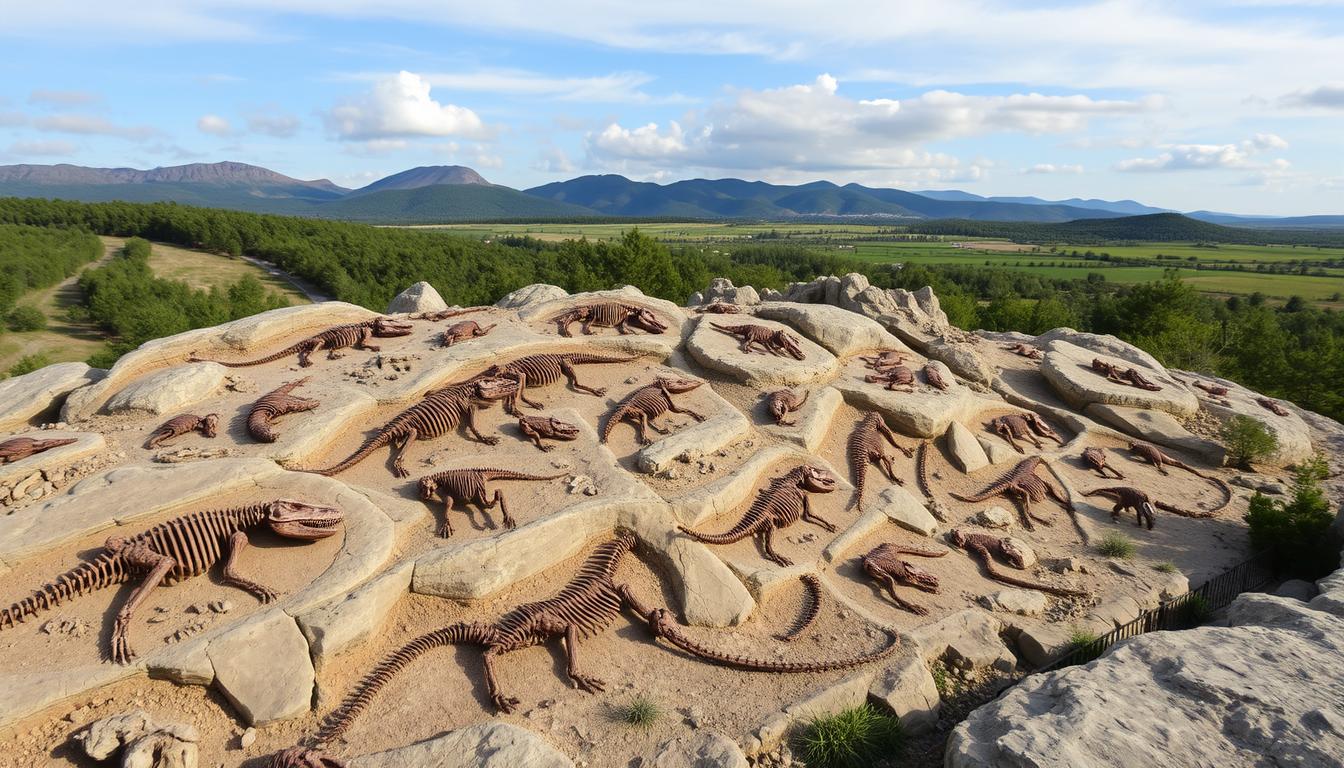
When Dinosaurs Ruled the Waves: Surprising Marine Dinosaur Discoveries
The iconic image of a lumbering Tyrannosaurus Rex or a graceful Brachiosaurus often conjures visions of lush, terrestrial landscapes. We associate “dinosaurs” with the land, with vast continents and the thunderous footsteps that shook the earth. But what if we told you that for a significant portion of the Mesozoic Era, the true rulers of our planet weren’t stomping through forests, but rather gliding, hunting, and dominating the vast, ancient oceans? While land-dwellers rightfully earn their fame, the story of the dinosaurs is incomplete without exploring the breathtaking, and often terrifying, world of their marine counterparts.
For over 100 million years, from the Triassic to the Cretaceous periods, the seas were a vibrant, dynamic theater of life, populated by an astonishing array of marine reptiles that, while not technically “dinosaurs” in the strictest paleontological sense, were often more colossal, more formidable, and more uniquely adapted than their terrestrial cousins. These weren’t simply aquatic lizards; these were titans of the deep, evolving incredible adaptations for a life spent entirely beneath the waves.
Beyond the Beach: The True Masters of the Mesozoic Seas
It’s a common misconception to believe that when dinosaurs reigned supreme on land, the oceans were sparsely populated or occupied by comparatively minor creatures. The reality is far more electrifying. As global sea levels rose during the Mesozoic, vast expanses of shallow seas and continental shelves formed, creating fertile grounds for a flourishing marine ecosystem. While our childhood fascination might have been captured by the likes of Stegosaurus or Triceratops, the deep blue was abuzz with a different, equally spectacular, cast of characters. These prehistoric ocean dwellers ruled the waves long before the emergence of modern sharks as the ocean’s apex predators.
The Triassic period, a time of recovery and diversification following the devastating Permian-Triassic extinction event, marked a significant turning point. Life on Earth was re-establishing itself, and the oceans became a cradle for innovation. Even before the true reign of land dinosaurs began, the seas were already teeming with life, setting the stage for the marine marvels to come.
The Giants of the Deep: A Gallery of Marine Marvels
While the term “marine dinosaur” is often used colloquially, it’s important to note that the true dinosaurs, defined by specific anatomical features like their upright posture, were terrestrial or semi-aquatic. The awe-inspiring creatures that dominated the seas were primarily marine reptiles. However, the sheer scale, predatory prowess, and evolutionary significance of these ancient ocean giants warrant their inclusion in any discussion of prehistoric powerhouses. They were, in essence, the “dinosaurs of the waves.”
Let’s dive into some of the most extraordinary examples:
| Creature | Epoch | Key Feature | Size Comparison |
|---|---|---|---|
| Plesiosaurus | Jurassic | Long, serpentine neck; paddle-like flippers | Neck longer than a bus |
| Ichthyosaurus | Triassic – Jurassic | Dolphin-like body; powerful tail fluke | Family car size |
| Mosasaurus | Cretaceous | Massive jaws; paddle-like limbs; serpentine tail | Small bus size |
| Pliosaurus | Jurassic | Shorter neck than plesiosaurs; immense skull | School bus length |
| Elasmosaurus | Cretaceous | Exceedingly long neck, up to 70 vertebrae | Airplane wing span |
| Shonisaurus | Triassic | Largest ichthyosaur; whale-like shape | Blue whale size |
The Serpentine Elegance: Plesiosaurs and Elasmosaurus
Imagine a creature with a neck so long it could rival a school bus. That was the reality of many plesiosaurs. These enigmatic marine reptiles, often associated with the popular image of the Loch Ness Monster, possessed long, flexible necks that they likely used to ambush prey from below, their small heads darting out of the water with surprising speed. Their bodies were broad and propelled by four large, paddle-like flippers, allowing for graceful, yet powerful, locomotion.
Among the most extreme of these was Elasmosaurus. With a neck that could stretch to an astonishing 23 feet (7 meters) long, containing up to 70 vertebrae – more than any land dinosaur – it was a true marvel of natural engineering. This elongated neck, coupled with a relatively small body, allowed it to sweep its head through vast swathes of water, scooping up fish and squid with ease.
The Swift Hunters: Ichthyosaurs
If plesiosaurs were the elegant hunters, ichthyosaurs were the torpedoes of the prehistoric seas. Appearing in the Triassic and flourishing throughout the Jurassic, these marine reptiles bore a striking resemblance to modern dolphins and ichthyosaurs. Their streamlined bodies, dorsal fins, and powerful tail flukes were perfectly adapted for speed and agility. They were viviparous, giving birth to live young, much like modern marine mammals.
The Triassic period was a golden age for these creatures. It marked a turning point for life on Earth, and the ichthyosaurs were among the earliest to truly conquer the marine realm. The giant Shonisaurus, a colossal ichthyosaur from the Late Triassic, reached lengths of over 40 feet (12 meters), dwarfing even many modern-day sharks and rivaling the size of a blue whale.
The Terrors of the Cretaceous: Mosasaurs
As the age of dinosaurs drew to a close, the Cretaceous period saw the rise of another fearsome group of marine predators: the mosasaurs. These were not lizards that returned to the sea, but rather a distinct lineage that evolved entirely marine adaptations. Possessing immense jaws lined with sharp, conical teeth, mosasaurs were the ultimate predators. Their powerful, serpentine bodies, coupled with paddle-like limbs and a strong tail, made them formidable hunters.
Consider the Mosasaurus, a name that sends shivers down the spine of any dinosaur enthusiast. This colossal reptile, reaching lengths of up to 50 feet (15 meters), was capable of crushing a small car with its jaws. They were opportunistic feeders, consuming fish, ammonites, other marine reptiles, and even, in some cases, other mosasaurs. They truly ruled the waves in the final millennia of the dinosaur era.
Shorelines and Convergence: Where Worlds Met
The ancient shorelines represented dynamic ecosystems where terrestrial and aquatic worlds converged. Towering dinosaurs might have patrolled the beaches, their roars echoing across the sand, while just offshore, colossal marine reptiles patrolled the prehistoric seas. These coastal environments were not just transitional zones; they were bustling hubs of activity, with marine life influencing terrestrial ecosystems and vice-versa.
The Legacy of the Seas
The study of these marine reptiles continues to reveal surprising insights into the evolution of life and the incredible adaptability of reptiles. From the serpentine elegance of plesiosaurs to the crushing power of mosasaurs, these creatures demonstrate that the story of prehistoric life is as much about the deep blue as it is about the dusty plains.
While the land-dwelling dinosaurs captured our imaginations for generations, it’s crucial to remember that the oceans of the Mesozoic were just as, if not more, spectacular. These were not mere footnotes to the age of dinosaurs; they were integral players, apex predators in their own right, shaping the marine environments they inhabited. The next time you picture the world when dinosaurs ruled, don’t forget to look beneath the waves – for there, you’ll find an equally, if not more, astonishing reign.

Additional Information
When Dinosaurs Ruled the Waves: Surprising Marine Dinosaur Discoveries
For generations, our imaginations have been captivated by the colossal reign of dinosaurs on land. We picture the thunderous footsteps of Tyrannosaurus Rex and the armored might of Stegosaurus. However, what often gets overlooked is that while these terrestrial titans dominated the continents, the ancient oceans were a realm of equally awe-inspiring, and often terrifying, life. The phrase “When Dinosaurs Ruled the Waves” isn’t a misnomer; it refers to the incredible diversity and dominance of marine reptiles that coexisted with, and in some cases, predated the land-dwelling dinosaurs. Recent discoveries continue to shed light on these surprising marine inhabitants, revealing a prehistoric world far more complex and water-dominated than previously understood.
The Dominance of Marine Reptiles: Not All “Dinosaurs” Swam
It’s crucial to clarify that while the phrase “marine dinosaurs” is colloquially used and understood to encompass the dominant marine life of the Mesozoic Era, scientifically, most of these creatures were marine reptiles, not true dinosaurs. True dinosaurs were primarily terrestrial, evolving from archosaur ancestors. However, during the Mesozoic Era – the period when dinosaurs ruled the Earth from roughly 252 to 66 million years ago – the oceans were a vibrant and dynamic ecosystem, teeming with a variety of reptiles that adapted to aquatic life. As summarized by Ocean Conservancy, “While the animals that delighted our childhood like the Stegosaurus or the Tyrannosaurus rex roamed the land; oceans, rivers, lakes and seas also had their fair share of spectacular marine-based creatures.”
These marine reptiles evolved from land-dwelling ancestors, gradually adapting to life in the water over millions of years. This period saw high global sea levels, creating vast shallow seas and expansive coastlines, which acted as fertile grounds for these aquatic behemoths.
The Reign of the Giants: Key Marine Reptile Groups
The Jurassic and Cretaceous periods, in particular, were golden ages for marine reptiles. These creatures occupied various ecological niches, from apex predators to filter feeders, and their diversity was remarkable.
-
Plesiosaurs: These are perhaps the most iconic “marine dinosaurs” in popular culture. Characterized by their long necks, small heads, and four large flippers, plesiosaurs were incredibly successful marine predators. As highlighted by discoverwildscience.com, some possessed “necks longer than school buses,” allowing them to strike at prey with astonishing reach. They were diverse, ranging from the long-necked, graceful forms to the shorter-necked, more robust pliosaurs, which were the true “sea monsters” of their time. Pliosaurs like Pliosaurus and Kronosaurus were immense, with jaws capable of crushing a car with their bite, as described in the Jurassic Oceans summary.
-
Ichthyosaurs: These marine reptiles bore a striking resemblance to modern-day dolphins and tuna, an example of convergent evolution. They were typically more streamlined than plesiosaurs and gave birth to live young at sea. Their well-preserved fossils often contain evidence of their last meals, showcasing their piscivorous (fish-eating) diets. They were a dominant group from the Triassic through the early Cretaceous periods.
-
Mosasaurs: While technically not “dinosaurs” in the strictest sense, these were formidable marine lizards that rose to prominence during the Late Cretaceous, after the extinction of ichthyosaurs and as plesiosaurs began to decline. As noted by discoverwildscience.com, mosasaurs “could crush a car with their jaws.” They were powerful predators with large bodies, paddle-like limbs, and a strong tail. Their reign was cut short by the same K-Pg extinction event that wiped out the non-avian dinosaurs.
-
Pterosaurs: Though often depicted alongside dinosaurs, pterosaurs were flying reptiles, not dinosaurs. However, many were adapted to a marine lifestyle, spending their lives soaring over the ocean, diving for fish, and nesting on coastal cliffs. Species like Pterodactylus and Pteranodon are well-known examples, and their connection to marine environments is undeniable.
A Surprising Pre-Dinosaur Marine World
It’s also important to note that the oceans were populated by formidable marine life even before the age of dinosaurs. The Triassic period, spanning from about 252 to 201 million years ago, saw the recovery and diversification of marine life after the devastating Permian-Triassic extinction event. As prehistoricsaurus.com points out, “These ancient marine animals ruled the waves long before sharks became the oceans’ top predators.” Early marine reptiles like placodonts (with their flattened, crushing teeth for feeding on hard-shelled invertebrates) and nothosaurs (long-snouted marine predators) were establishing their dominance in these ancient seas.
Dynamic Coastal Ecosystems: Where Worlds Converged
The ancient shorelines were not just passive boundaries between land and sea; they were vibrant and dynamic ecosystems. As dino-world.com aptly describes, “towering dinosaurs patrolling the beaches and massive marine reptiles ruling the prehistoric seas, these ancient shorelines represented dynamic ecosystems where terrestrial and aquatic worlds converged.” This intersection of environments meant that terrestrial dinosaurs likely interacted with marine life, perhaps preying on coastal creatures or being preyed upon by large marine reptiles venturing close to shore. This highlights a more integrated view of prehistoric life, where land and sea were not entirely separate domains.
The Continuing Quest for Discovery
Our understanding of these prehistoric marine giants is constantly evolving thanks to ongoing paleontological research. The discovery of new species, more complete fossil specimens, and advancements in analytical techniques continue to refine our knowledge of their anatomy, behavior, and ecological roles. Documentaries like the one mentioned by Youtube user “Prehistoric Sea Monsters” underscore the public fascination and the scientific drive to uncover more about these “terrifying marine” inhabitants that ruled the prehistoric oceans.
In conclusion, the era of dinosaurs was also the era of magnificent marine reptiles. These “dinosaurs of the sea,” though not true dinosaurs, were vital and dominant players in the Mesozoic world. From the serpentine necks of plesiosaurs to the crushing jaws of mosasaurs, and even the pre-dinosaurian marine empires, the ancient oceans were a realm of power, diversity, and constant evolutionary innovation, a testament to the fact that life, in its most spectacular forms, has always thrived both on land and beneath the waves.

